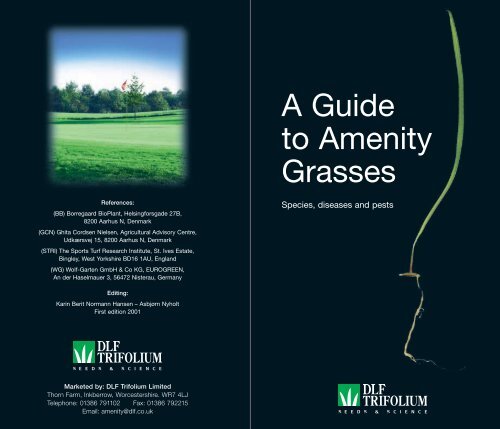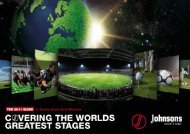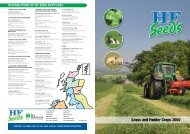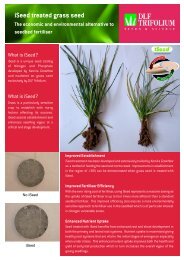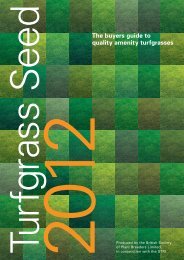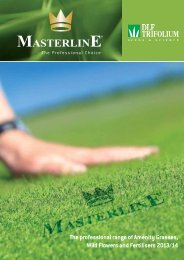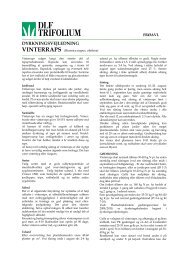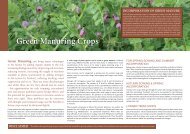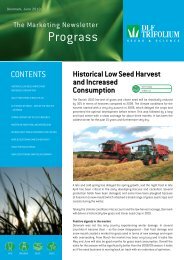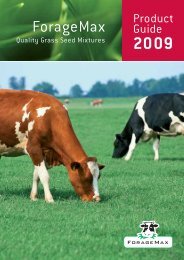Download a copy here - dlf-trifolium
Download a copy here - dlf-trifolium
Download a copy here - dlf-trifolium
- No tags were found...
Create successful ePaper yourself
Turn your PDF publications into a flip-book with our unique Google optimized e-Paper software.
A Guide<br />
to Amenity<br />
Grasses<br />
References:<br />
(BB) Borregaard BioPlant, Helsingforsgade 27B,<br />
8200 Aarhus N, Denmark<br />
(GCN) Ghita Cordsen Nielsen, Agricultural Advisory Centre,<br />
Udkærsvej 15, 8200 Aarhus N, Denmark<br />
(STRI) The Sports Turf Research Institute, St. Ives Estate,<br />
Bingley, West Yorkshire BD16 1AU, England<br />
(WG) Wolf-Garten GmbH & Co KG, EUROGREEN,<br />
An der Haselmauer 3, 56472 Nisterau, Germany<br />
Species, diseases and pests<br />
Editing:<br />
Karin Berit Normann Hansen – Asbjørn Nyholt<br />
First edition 2001<br />
Marketed by: DLF Trifolium Limited<br />
Thorn Farm, Inkberrow, Worcestershire. WR7 4LJ<br />
Telephone: 01386 791102 Fax: 01386 792215<br />
Email: amenity@<strong>dlf</strong>.co.uk
2 INTRODUCTION<br />
Leaves<br />
bristle like<br />
Leaves<br />
expanded<br />
Leaf<br />
rolled in<br />
Shoot<br />
Leaves<br />
not hairy<br />
Leaf folded<br />
in shoot<br />
Leaves hairy<br />
Auricles<br />
Present<br />
Auricles<br />
absent<br />
Rhizomes Present<br />
No rhizomes<br />
Upper leaf surface ribbed<br />
Upper leaf surface not ribbed<br />
Auricles<br />
Present<br />
Auricles<br />
absent<br />
Remains of old Leaf sheaths at base<br />
No remains of old Leaf sheaths at base<br />
Rhizomes or stolen Present<br />
White rhizomes Present<br />
No rhizomes<br />
Red veins on basal sheath<br />
No red veins<br />
Base bulbous. Dark brown Leaf sheaths<br />
Base not bulbous. Purple Leaf sheath<br />
RED FESCUE Festuca rubra trichophylla<br />
CHEWINGS/SHEEP’S/HARDY FESCUE Festuca rubra SSP Commutata/Festuca ovina<br />
Auricles Present<br />
No auricles<br />
Tramlines Present<br />
No tramlines<br />
No rhizomes<br />
Hairs on auricles<br />
Hairless auricles<br />
Rhizomes<br />
Stolens<br />
PERENNIAL RYEGRASS Lolium perenne<br />
CRESTED DOGSTAIL Cynosurus cristatus<br />
MEADOW GRASSES Poa pratensis<br />
COCKSFOOT Dactylis glomerata<br />
COUCH Agropyron repens<br />
BARLEY GRASS<br />
YORKSHIRE FOG Holcus lanatus<br />
TALL FESCUE Festuca arundinacea<br />
MEADOW FESCUE Festuca pratensis<br />
ITALIAN RYEGRASS Lolium multiflorum<br />
BLACK BENT<br />
CREEPING BENT Agrostis stoloniferea<br />
TIMOTHY Phleum pratensis<br />
BLACKGRASS<br />
A PRACTICAL GUIDE TO GRASS IDENTIFICATION<br />
Grass Specimen<br />
No rhizomes or stolen Present<br />
Rhizomes Present CREEPING SOFT GRASS<br />
BROME GRASS
4<br />
THE VARIOUS PARTS OF THE GRASS<br />
AND THEIR STRUCTURES<br />
Leaf tip<br />
The leaf bud<br />
Rolled<br />
Folded<br />
Leaf blade<br />
The leaf tip<br />
Boat shaped<br />
Pointed<br />
The leaf blade<br />
Smooth or ribbed blade<br />
with or without keel<br />
Leaf blade with two pale<br />
parallel lines<br />
keel<br />
Pale parallel<br />
lines<br />
Leaf sheath<br />
The ligule<br />
Long or short ligule<br />
Leaf sheath/auricle<br />
Large or small<br />
Leaf shoot<br />
(visible in section)<br />
The stem<br />
Can have nodes<br />
Leaf sheath is the part<br />
of the grass leaf which<br />
grasps the stem.<br />
Auricles are small claw<br />
or ear-like outgrowths at<br />
the junction of leaf sheaf<br />
and blade.<br />
Leaf<br />
blade<br />
Ligule<br />
Auricle<br />
Leaf<br />
sheaf
6<br />
GRASSES<br />
Smooth-stalked meadow grass<br />
Latin name:<br />
Poa pratensis<br />
Smooth stalked meadow grass has stiff blue-green<br />
leaves with boat-shaped tip.<br />
Two pale parallel<br />
lines are visible<br />
along the leaf’s<br />
midrib.<br />
Clear leaf<br />
sheath/auricles<br />
in perennial<br />
ryegrass.<br />
The short ligule<br />
is visible on the<br />
left leaf.<br />
Meadow grass which has formed underground<br />
rhizomes.<br />
Leaves<br />
and stems<br />
reddish at<br />
base.<br />
Perennial<br />
ryegrass has<br />
strong dark<br />
green leaves.<br />
The underside<br />
of the leaf<br />
is glossy.<br />
Seed weight: 0.2g/1000 seeds<br />
Germination: 3-4 weeks<br />
Shoot density: 200-350 shoots/100cm 2<br />
Cutting height: Normal: 20-35mm. Not less than 8mm.<br />
Growth: In tufts with rhizomes.<br />
Distinguishing<br />
features: Leaves dark green or with bluish bloom.<br />
Of uniform width, abruptly terminating in boat-shaped tip.<br />
Two pale parallel lines visible along midrib when leaf is<br />
held up against light.<br />
Underside of leaf with keel.<br />
Leaf blade folded in the shoot.<br />
Ligule short, rounded, 1-3mm long.<br />
Mown turf rarely flowers.<br />
Properties:<br />
Perennial ryegrass<br />
Latin name:<br />
Forms an attractive carpet with good wearing qualities<br />
and regenerative ability. Slow to establish. Ideal for turf<br />
production, tees and sports areas.<br />
Lolium perenne<br />
Seed weight: 2.0g/1000 seeds<br />
Germination: 1-2 weeks<br />
Shoot density: 200-350 shoots/100cm 2<br />
Cutting height: Normal: 28-40mm. Not less than 8mm.<br />
Growth: In tufts.<br />
Distinguishing<br />
features: 2-5mm strong dark green leaves.<br />
Widest at base, width gradually decreasing to fine tip.<br />
Upper leaf surface dull with clear ribs.<br />
Underside of leaf glossy with prominent keel.<br />
Leaves and stems reddish at base.<br />
Leaf blade folded in the shoot.<br />
Ligule up to 2mm long.<br />
Clear sheath/auricle.<br />
Properties: Perennial ryegrass has very good wearing qualities<br />
and germinates quickly. The species is thus highly<br />
suitable for sports areas and hard wearing lawns.<br />
Ideal for overseeding because of its high germination<br />
in a range of soils.
8<br />
GRASSES<br />
The underside<br />
of the leaf has<br />
very clear ribs.<br />
Tall fescue<br />
Latin name:<br />
Festuca arundinacea<br />
Small, narrow<br />
spreading<br />
auricles,<br />
minutely hairy<br />
along the edge.<br />
Some varieties do<br />
form rhizomes.<br />
Seed weight: 1.8-2.5g/1000 seeds<br />
Germination: 2-3 weeks<br />
Shoot density: 200 shoots/100cm 2<br />
Cutting height: Normal: 30-40mm. Not less than 10mm.<br />
Growth: In tufts.<br />
Distinguishing<br />
features:<br />
Properties:<br />
Strongly veined leaf.<br />
Blade rolled when young.<br />
Large flat mature leaf.<br />
Purple red leaf sheath.<br />
Ligules short.<br />
Large auricles.<br />
Hairy.<br />
Very good resistance to extremes of heat and cold.<br />
Very high drought tolerance. Moderate to good wear<br />
tolerance. Some varieties do form rhizomes.<br />
Sheep’s fescue/Hard fescue<br />
Latin name:<br />
Festuca ovina<br />
Seed weight: 1.0g/1000 seeds<br />
Germination: 2-3 weeks<br />
Shoot density: 800-1000 shoots/100cm 2<br />
Cutting height: Normal: 15-35mm. Not less than 5mm.<br />
Distinguishing<br />
features: Very fine leaved plant with high shoot density.<br />
Leaves are thread like, hairless with a deeply ridged<br />
upper surface.<br />
Leaves greyish to blue green colouration.<br />
Characteristically forms whorls as a mature plant.<br />
Auricles are described as absent or much reduced,<br />
ligule is very short.<br />
Rhizomes absent.<br />
Properties: A highly drought tolerant, low nutrient demand grass.<br />
Some cultivars tolerate very close mowing. A highly<br />
flexible species used in a diverse range of mixtures<br />
from golf to moor land. It is particularly useful in<br />
low maintenance situations and has a tolerance to<br />
a wide range of soils from acidic to highly basic.<br />
Visually attractive if left uncut.
10<br />
GRASSES<br />
Red fescue<br />
without rhizomes.<br />
Roots bunched<br />
together.<br />
Filamentous<br />
leaf with<br />
smooth<br />
underside.<br />
Tuft formation<br />
in red fescue.<br />
Plant with<br />
very fine<br />
leaves.<br />
Chewings fescue<br />
Latin name:<br />
Festuca rubra commutata<br />
Seed weight: 1.0g/1000 seeds<br />
Germination: About 2 weeks<br />
Shoot density: 450-800 shoots/100cm 2<br />
Cutting height: Normal: 20-35mm. Not less than 5mm.<br />
Growth: In tufts.<br />
Distinguishing<br />
features:<br />
Properties:<br />
Leaves fine, stiff and filamentous.<br />
Young leaf folded in shoot.<br />
Ligule short, blunt, difficult to distinguish.<br />
Roots bunched together.<br />
No rhizomes.<br />
The high shoot density and tolerance to close cutting<br />
makes the species particularly suitable for greens,<br />
tees, fairways and ornamental lawns.<br />
Requires minimal water and fertiliser. Tolerates acidic<br />
soils.<br />
Slender creeping red fescue<br />
Red fescue<br />
with short<br />
rhizomes.<br />
Red fescue<br />
with short<br />
rhizomes.<br />
Plant with<br />
filamentous<br />
leaves.<br />
Latin name:<br />
Festuca rubra trichophylla<br />
Seed weight: 1.0g/1000 seeds<br />
Germination: About 2 weeks<br />
Shoot density: 400-700 shoots/100cm 2<br />
Cutting height: Normal: 20-35mm. Not less than 5mm.<br />
Growth: Short rhizomes.<br />
Distinguishing<br />
features:<br />
Properties:<br />
Leaves stiff and filamentous.<br />
Young leaf folded in shoot.<br />
Ligule short, blunt and difficult to distinguish.<br />
Short rhizomes.<br />
The high shoot density and tolerance to close cutting<br />
makes the species particularly suitable for greens, tees,<br />
fairways and ornamental lawns. Moderately salt tolerant.<br />
The runners can regenerate cover in worn areas. Mixes<br />
well with F. r. commutata.
12<br />
GRASSES<br />
Strong creeping red fescue<br />
Latin name:<br />
Festuca rubra rubra<br />
Comparison of the three red fescue types.<br />
Left: without rhizomes; middle: with short<br />
rhizomes; right: with long rhizomes.<br />
Red fescue with long rhizomes.<br />
Filamentous<br />
leaves in red<br />
fescue.<br />
Seed weight: 1.0g/1000 seeds<br />
Germination: About 2 weeks<br />
Shoot density: 250-450 shoots/100cm 2<br />
Cutting height: Normal: 20-35mm. Not less than 12mm.<br />
Growth: Long rhizomes.<br />
Distinguishing<br />
features:<br />
Properties:<br />
Leaves stiff and filamentous.<br />
Young leaf folded in shoot.<br />
Ligule short, blunt and difficult to distinguish.<br />
Long rhizomes.<br />
Rhizamatous growth stabilises root zones and provides<br />
some recovery from damage. This species is used in turf<br />
production (for binding) and areas not subject to very<br />
close mowing. Strong creeping red fescue is not suited<br />
to close mown areas such as golf greens. It is however<br />
used in some tees and fairway mixtures as it has some<br />
regenerative capacity due to its rhizomes.<br />
Browntop bent grass<br />
Leaf with<br />
clear ribs.<br />
Ligule<br />
short and<br />
evenly<br />
truncated.<br />
Browntop<br />
bent grass.<br />
Rhizomes are<br />
visible.<br />
Latin name:<br />
Agrostis capillaris syn. tenuis<br />
Seed weight: 0.1g/1000 seeds<br />
Germination: 2-3 weeks<br />
Shoot density: 400-600 shoots/100cm 2<br />
Cutting height: Normal: 4-5mm; good durability at 5mm.<br />
Growth: Mainly short rhizomes.<br />
Distinguishing<br />
features:<br />
Properties:<br />
Leaves matt green and broadest at base, gradually<br />
narrowing to a fine tip.<br />
Leaf with parallel vernation, no keel. Upper surface<br />
and lower surface of similar appearance.<br />
Leaf rolled in shoot.<br />
Ligule short, truncated, 0.5-2.0mm long.<br />
Short rhizomes, to lesser degree stolons.<br />
Ideal for greens in mixture with F. r. commutata and<br />
F. r. trichophylla. Does best under relatively poor growth<br />
conditions. Over-fertilising, over-watering and compact<br />
or waterlogged soil will result in displacement of the<br />
species by annual meadow grass.
14<br />
GRASSES<br />
Creeping<br />
bent grass<br />
with surface<br />
runners.<br />
Creeping bent grass<br />
Latin name:<br />
Seed weight:<br />
Agrostis stolonifera<br />
0.4g/1000 seeds<br />
Germination:<br />
About 2 weeks<br />
Left: creeping<br />
bent grass with<br />
long toothed<br />
ligule.<br />
Right: browntop<br />
bent grass with<br />
short ligule.<br />
Shoot density: 400-600 shoots/100cm 2<br />
Cutting height: Normal: 3-4mm. Not over 15mm.<br />
Growth: Surface runners.<br />
Distinguishing<br />
features:<br />
Leaves matt grey-green and broadest at base, gradually<br />
narrowing to fine tip.<br />
Leaf with ribs above.<br />
Leaf rolled in shoot.<br />
Ligule rounded, lightly toothed, up to 5 mm long.<br />
Can root at nodes.<br />
Numerous stolens.<br />
Stem with<br />
pointed<br />
leaves and<br />
violet nodes.<br />
Properties:<br />
Of the various species, this species tolerates the<br />
closest cutting. Relative to browntop bent grass,<br />
requires intensive management, fertilising and watering.<br />
Has a long dormant period in winter.<br />
Annual meadow grass<br />
Stem with long<br />
ligule.<br />
Annual meadow<br />
grass has pale<br />
green leaves with<br />
transverse lines.<br />
Left: annual<br />
meadow grass with<br />
pale green leaves<br />
and silver seed<br />
heads. Right:<br />
smooth stalked<br />
meadow grass with<br />
strong blue-green<br />
leaves.<br />
Annual meadow grass<br />
with seed heads in turf<br />
cut below 5 mm.<br />
Latin name: Poa annua<br />
Seed weight: 0.4g/1000 seeds<br />
Germination: 1-2 weeks<br />
Shoot density: Very dense in tended greens.<br />
Cutting height: Down to 3mm.<br />
Growth: Forms tufts.<br />
Distinguishing<br />
features:<br />
Leaves pale green and of uniform width, abruptly<br />
terminating in boat-shaped tip.<br />
Leaves often with transverse lines.<br />
Two pale parallel lines visible along midrib when leaf held<br />
up against light.<br />
Underside of leaf with keel.<br />
Leaf folded in shoot.<br />
Ligule rounded, gently serrated, up to 5mm.<br />
Can flower even on greens cut down to a few mm.<br />
Properties:<br />
Common weed. Undesired species in all lawns. Often<br />
occurs on soils with poor structure with a thatch layer.<br />
Benefits from over-fertilising, especially with nitrogen<br />
and phosphorus and from heavy watering. Highly<br />
variable species.
16<br />
FUNGAL DISEASES<br />
Attack by<br />
anthracnose.<br />
The turf is thin<br />
with yellow<br />
and red-brown<br />
plants (STRI).<br />
Early attack<br />
by anthracnose.<br />
The attacked<br />
plants are<br />
yellow (WG).<br />
Anthracnose/Basal rot<br />
Latin name:<br />
Symptoms:<br />
Hosts:<br />
Time:<br />
Colletotrichum graminicola<br />
Early attacks are evident as a yellowish discoloration<br />
of individual plants throughout the turf. Continued<br />
development of the disease depends on temperature<br />
and humidity.<br />
In humid weather at temperatures below 20˚C, 1-3cm<br />
irregular yellowish spots are formed. The youngest<br />
leaves in plants which have been attacked are often<br />
yellow-orange. Root rot can also occur. Plants which<br />
have been attacked can t<strong>here</strong>fore easily be pulled<br />
out of the ground.<br />
Large irregular yellow to red-brown spots are seen in hot<br />
humid weather (> 25˚C). When the plants wither away,<br />
the turf becomes thin with bare patches.<br />
Anthracnose often occurs w<strong>here</strong> the soil has become<br />
compact, lacks fertiliser and is wet.<br />
Can attack all turf grass species, but annual<br />
meadowgrass is particularly susceptible.<br />
Attacks occur especially from June to August, but can<br />
occur throughout the year.<br />
Fairy rings<br />
Fairy ring<br />
type 2 forms<br />
rings with<br />
strong grass<br />
growth (STRI).<br />
Fairy ring type 1 forms rings<br />
in which the turf withers and<br />
dies. This ring is surrounded<br />
by two rings with strong<br />
growth of the grass (STRI).<br />
Fairy ring type 3<br />
apparently does<br />
not affect the grass,<br />
but forms rings of<br />
mushrooms or puffballs.<br />
Latin name:<br />
Symptoms:<br />
Type 1:<br />
Type 2:<br />
Type 3:<br />
Hosts:<br />
Time:<br />
Marasmius oreades, Scleroderma spp.,<br />
Hygrophorus spp. etc.<br />
Fairy rings can vary greatly in size from a few centimetres<br />
in diameter upwards, but on most turf the limit is often<br />
a diameter of 5-10 metres. Fairy rings are classified in<br />
different types according to their appearance.<br />
Forms rings w<strong>here</strong> the grass withers and dies. A dark<br />
green ring with strong grass growth is formed on both<br />
sides of this ring. T<strong>here</strong> may be mushrooms or puffballs<br />
around the ring.<br />
The white fungal mycelium with its typical mouldy smell<br />
is visible in the soil under the wit<strong>here</strong>d plants. This type<br />
of fairy ring can cause major damage.<br />
Forms dark green rings in which the grass grows more<br />
strongly than the rest of the turf. Mushrooms or puffballs<br />
may grow around the ring.<br />
Forms rings of mushrooms or puffballs, but t<strong>here</strong> is no<br />
visible effect on the grass.<br />
Can attack all species of turf grass.<br />
Once present, fairy rings are often a problem for a<br />
number of years.
18<br />
FUNGAL DISEASES<br />
Fusarium patch/Pink snow mould<br />
Latin name:<br />
Microdochium nivale/Fusarium nivale/Gerlachia nivalis<br />
Fusarium attack. The plants are<br />
waterlogged (STRI).<br />
Spots under attack by pink snow<br />
mould grow and coalesce (STRI).<br />
Symptoms:<br />
Hosts:<br />
Time:<br />
Damage appears not only after snow, but also in humid<br />
weather at temperatures just above freezing. Patches of<br />
4-6cm with grey waterlogged plants are seen when the<br />
attack commences. The patches spread to form plate-size<br />
areas which coalesce. A dark brown rim is often seen<br />
along the outermost edge w<strong>here</strong> the infection is active.<br />
A grey-white to pink cottony mycelium forms over<br />
the attacked area when the humidity is high enough.<br />
This resembles a paper-like layer after snow.<br />
The grass regenerates from the middle of the patch.<br />
Can attack all species of turf grass, but bent grass,<br />
annual meadowgrass and perennial ryegrass are<br />
particularly susceptible.<br />
Fusarium is the most important fungal disease of turf<br />
grass at temperatures below 3˚C with high humidity.<br />
The damage is seen throughout autumn and winter<br />
and after any snow has melted in March. Heavy rainfall<br />
can dislodge spores and infections can follow run<br />
off patterns.<br />
Grey snow mould/Typhula blight<br />
Attack by typhula blight.<br />
The grass is dried and<br />
adhering together in a<br />
paper-like structure.<br />
Golden brown bodies<br />
are visible in the middle<br />
of the picture (GCN).<br />
Latin name:<br />
Symptoms:<br />
Hosts:<br />
Time:<br />
Typhula incarnata<br />
The infection spreads rapidly under snow, w<strong>here</strong> the<br />
humidity is high and the temperature around freezing<br />
point. The little grey spots are visible on the turf<br />
when the snow melts. The individual grass plant dries<br />
out and withers to a dry papery structure. If the humidity<br />
is high enough, a greyish-white mycelium is formed.<br />
The areas which have been attacked are often 50cm<br />
wide. A typical feature of grey snow mould is the<br />
golden brown sclerotised bodies the size of a pinhead.<br />
The sclerotised bodies are found on dried-out leaves<br />
and at the base of the roots.<br />
The attacked areas rarely die, but regenerate relatively<br />
quickly in spring.<br />
Can attack all turf grass species, but bent grass, annual<br />
meadowgrass and perennial ryegrass are particularly<br />
susceptible.<br />
Attacks occur from October from March.<br />
Golden brown bodies on<br />
attacked plants (GCN).
20<br />
FUNGAL DISEASES<br />
The characteristic<br />
reddish filaments<br />
formed at the ends<br />
of attacked plants<br />
(STRI).<br />
Red thread/Corticium disease<br />
Latin name:<br />
Symptoms:<br />
Hosts:<br />
Time:<br />
Laetisaria fuciformis/Corticium fuciforme<br />
Attacks are first evident as small irregular 2-5cm pale<br />
brown spots which later become straw-coloured.<br />
Healthy plants are often seen in among those under<br />
attack. The spots can overlap and form extensive areas.<br />
The fungus subsequently develops the typical reddish<br />
filaments at the ends of the attacked leaves, forming an<br />
antler-like structure. The attacked areas thus gain a<br />
characteristic reddish tinge.<br />
Can attack all species of lawn grass, but is most<br />
common on ryegrass and red fescue.<br />
Damage is seen from March to October. Attacks are<br />
promoted by humid weather and a temperature of<br />
16-22˚C.<br />
The attacked area<br />
with red filaments<br />
has pale brown<br />
to reddish spots<br />
(STRI).<br />
Rust attack on<br />
meadowgrass<br />
(GCH).<br />
Rust<br />
Latin name:<br />
Symptoms:<br />
Hosts:<br />
Time:<br />
Puccinia and Uromyces spp.<br />
Early attacks are visible as small pale yellow spots on<br />
the leaves. The spots become bigger as the fungus<br />
grows into the leaf. Large numbers of yellow, brown<br />
or black microscopic spores are subsequently formed.<br />
The spores’ appearance depends on the type of rust.<br />
The typical “fine powder” or “dust layer” is seen on<br />
the leaves when the spores are released. Turf which<br />
has been heavily attacked by the disease can have<br />
a yellowish or brownish colour.<br />
The spores are spread by the wind and by people and<br />
machinery, and the disease can thus spread rapidly to<br />
other areas. The attack weakens the plants and the<br />
turf becomes thin.<br />
Can attack all species of turf grass.<br />
Damage is seen from June to September. Rust fungi<br />
typically develop at temperatures above 20˚C on<br />
stressed plants.<br />
Rust attack on<br />
ryegrass (GCN).
22<br />
FUNGAL DISEASES/PESTS<br />
Take-all patch/Ophiobolus patch<br />
Latin name:<br />
Gaeumannomyces graminis<br />
Ring structures formed in attack<br />
by take-all patch (STRI).<br />
An older take-all<br />
patch ring formation<br />
with the typical<br />
reddish-brown to<br />
bronze colour (WG).<br />
Symptoms:<br />
Hosts:<br />
Time:<br />
Attacks are seen as irregular 5-10cm dark green<br />
spots which later become pale to reddish-brown or<br />
bronze-coloured. A ring structure is formed in the turf<br />
when the attack becomes more serious. The ring recurs<br />
in the same place year after year, but grows in size.<br />
The fungus attacks the plants’ stems and roots, which<br />
then wither and are easily pulled out of the ground.<br />
The roots have a typical black-brown colour. T<strong>here</strong> is a<br />
marked change in the composition of the turf inside the<br />
ring. Instead of the existing species mix, red fescue and<br />
broad-leafed forms of annual meadowgrass are typically<br />
found together with weeds such as pearlwort/sagini and<br />
chickweed. This change is permanent.<br />
The disease is a particular problem on newly established<br />
greens in the first 3-4 years.<br />
Take-all patch attacks mainly bentgrasses, but ryegrass<br />
and meadowgrass can also be attacked.<br />
Damage is seen from May to October. The disease is a<br />
particular problem in cold wet years.<br />
Crane fly<br />
Crane fly larvae are<br />
grey-brown and about<br />
4cm long when fully<br />
grown (GCN).<br />
The crane fly is a big slender<br />
midge with a body length of<br />
about 2cm (GCN).<br />
The clear<br />
spiracles and<br />
pointed<br />
outgrowths<br />
on the crane<br />
fly larva<br />
(GCN).<br />
Latin name:<br />
Symptoms:<br />
Hosts:<br />
Time:<br />
Tipula paludosa<br />
Adult crane flies do no damage. The larvae, which hatch<br />
from August to September, chew the plants’ roots,<br />
shoots and leaves.<br />
Attacks are evident when the plants adopt a “dirty brown”<br />
colour. The plants wither and the turf becomes thin.<br />
The larvae eat the roots during the day and on hot humid<br />
nights they come up to eat the lower parts of the foliage.<br />
Frayed areas are seen on roots, shoots and leaves.<br />
Major damage to the lawn can often be seen when<br />
rooks and other crows have been pecking after the<br />
larvae. The birds can often scrape up extensive areas<br />
of the lawn.<br />
The crane fly is very common and widespread. T<strong>here</strong> are<br />
also other species of crane fly.<br />
Can attack all species of turf grass.<br />
Minor damage is seen in autumn from September,<br />
when the eggs hatch and the little larvae begin to eat<br />
the plants. Major damage is seen in spring from April,<br />
when the bigger larvae have big appetites. Pupation is<br />
in late June.
24<br />
PESTS<br />
Fever fly larvae<br />
have a dark head<br />
and thorny growths<br />
on the body (GCN).<br />
The adult fever fly<br />
looks like a typical<br />
fly and is 5-6mm<br />
long and very<br />
hairy (GCN).<br />
Fever fly attack. Plants<br />
are bitten off just below<br />
the surface of the ground<br />
(GCN).<br />
Fever fly<br />
Latin name:<br />
Symptoms:<br />
Hosts:<br />
Time:<br />
Dilophus febrilis<br />
The larvae often eat dead plant parts at the base of<br />
the grass, but if the number of larvae becomes so<br />
large that t<strong>here</strong> is not enough food, living plants can<br />
be consumed. The plants are bitten off just below<br />
ground level, after which they wither and can easily<br />
be pulled up. The larvae usually appear in the ground<br />
in large numbers like maggots in a piece of meat.<br />
Extensive damage results when birds peck into the<br />
grass in search of the larvae. Large areas of grass<br />
can be cut up.<br />
Can attack all species of turf grass.<br />
Fever flies have two generations a year.<br />
The first generation causes damage in June and July.<br />
The second generation causes damage in autumn and<br />
spring until the end of April, when the larvae pupate.<br />
Frit fly<br />
Frit fly larvae are<br />
about 4-5mm long<br />
without head and<br />
appendages (GCN).<br />
Frit fly attack in ryegrass. The main<br />
shoots are yellow (GCN).<br />
Latin name:<br />
Symptoms:<br />
Hosts:<br />
Time:<br />
Oscinella frit<br />
The adult frit fly does no damage. The damage occurs<br />
when the larvae feed on the plant’s main shoot and the<br />
roots. The plant cells die and the main shoot becomes<br />
yellow and wilts away.<br />
The main shoot can easily be pulled out of the plant<br />
and the damage done by the larva can be seen at the<br />
bottom of the shoot.<br />
The plant stops growing upwards and forms side shoots.<br />
When the larvae feed on the roots, the plants<br />
become yellow and wither and can easily be pulled<br />
out of the ground.<br />
All turf grasses can be attacked, but the ryegrasses, red<br />
fescue and the meadow grasses are most susceptible.<br />
Frit fly larvae hatch three times a year, in May-June,<br />
July-August, and August-September. The third<br />
generation causes the greatest damage in September<br />
and October.<br />
Adult frit flies in a container. The flies are<br />
shiny black with brick-red eyes and<br />
are about 2-2.5mm long (GCN).
26<br />
PESTS<br />
The adult June beetle<br />
is about 1 cm long, green in<br />
front with shiny brown elytra<br />
(wing covers) (GCN).<br />
June beetle larvae are about 1-2cm<br />
long, whitish with 3 pairs of legs<br />
and a shiny brown head. The larvae<br />
usually lie in a C-shape (GCN).<br />
June beetle larval attack<br />
on green (BB).<br />
June beetle<br />
Latin name:<br />
Symptoms:<br />
Hosts:<br />
Time:<br />
Phylloptera horticola<br />
Damage occurs when the larvae chew on the plants’<br />
roots. The plants become yellow and wither. The June<br />
beetle lays its eggs in May-June. The egg hatches<br />
in 2-3 weeks and the first two larval stages move<br />
deep into the soil (15cm) and do not chew the roots<br />
extensively. The third larval stage appears about<br />
1st August. The larvae then move up into the top layer<br />
of soil and damage grasses throughout autumn.<br />
They overwinter deep in the ground and pupate in spring.<br />
Extensive damage occurs when rooks and other crows<br />
peck into the grass to find the larvae. Large areas of<br />
grass can be scraped up.<br />
Can attack all turf grass species.<br />
Minor damage is seen in autumn, when the little larvae<br />
begin to feed on the plants. Major damage is seen<br />
in spring, when the bigger larvae have big appetites.<br />
Pupation is in May.<br />
Leaf weevil<br />
The adult leaf<br />
weevil is about<br />
6-8mm long,<br />
brown-green<br />
with a metallic<br />
sheen (GCN).<br />
Leaf weevil larvae are about<br />
8mm long, white, limbless,<br />
with brown head (GCN).<br />
Leaf weevil larvae bite off the<br />
roots just below ground level<br />
so that the grass can be<br />
rolled up like a carpet (GCN).<br />
Latin name:<br />
Symptoms:<br />
Hosts:<br />
Time:<br />
Phyllobius pyri, P. maculicornis and P. vespertinus<br />
The adults do no damage. Damage occurs when the<br />
larvae feed on the roots. The roots are chewed just<br />
below ground level, so that the grass can almost be<br />
rolled up like a carpet. If the plants are pulled up, the<br />
larvae can be seen in or immediately below the surface<br />
of the soil. Early attacks are evident as individual dead<br />
shoots or several wit<strong>here</strong>d plants. Bigger or smaller<br />
spots are seen on the turf, especially in areas with<br />
lighter soils.<br />
Can attack all species of turf grass, but the fine-leafed<br />
species such as fescues are especially susceptible<br />
to attack.<br />
Damage is most often seen in August and September.<br />
Major attacks can occur in June and August<br />
in particularly dry years. Pupation is from the end<br />
of September.


